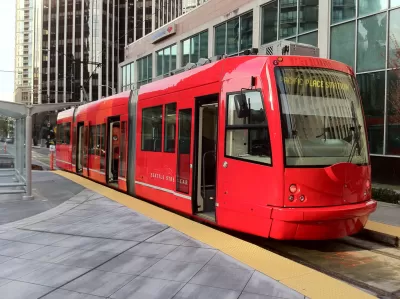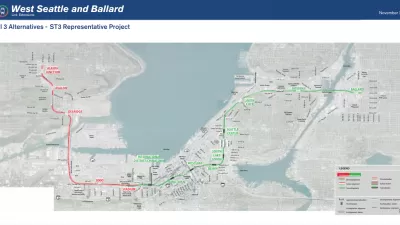In dollars, Seattle region's Proposition 1 was second only to Measure M, a $120 billion sales tax measure in Los Angeles County, although the comparison is lacking in at least three respects. Prop 1 did not pass in all three Puget Sound counties.

In an article updated on Nov. 10, the Seattle Times staff reported that the three-county "Proposition 1 was logging 58 percent approval in King County on Wednesday, and 52 percent in Snohomish County. In Pierce County, 56 percent of voters were rejecting the tax proposal."
Overall, in the three-county Sound Transit district, 54 percent were voting to approve.
Sound Transit declared victory on Nov. 10, though as of Nov. 18, Pierce County had counted 73 percent of ballots.
Unlike the other big transit winner on election day which called for a new half-cent sales tax and the extension of an existing half-cent sales tax, Proposition 1 was not based solely on regressive sales taxes. In addition to a half-cent sales tax, Prop 1 called for approval of:
- A property tax of $25 a year per $100,000 of assessed value
- 0.8% motor-vehicle excise tax or 'car tab' ($80 annually on a $10,000 vehicle)
The three taxes, which begin Jan. 1, 2017, are estimated to raise $27.7 billion through 2041 [25 years]. Combined with other sources, passage of the proposition will fund the $53.8 billion Sound Transit 3 plan (ST3). Per the plan's fact sheet [PDF]:
The Sound Transit 3 Plan obligates the Board to roll back taxes to the level required for permanent operations and maintenance following completion of transit projects, unless a future ballot measure directs otherwise.
According to Sound Transit, the transit plan [PDF] "will improve and expand the regional mass transit system by connecting the major cities in King, Pierce and Snohomish counties with light rail, Bus Rapid Transit (BRT), express bus and commuter rail." Note the seven Planetizen posts tagged ST3.
Proposition 1 in comparison to outcomes of other regional transit measures on Nov. 8
Unlike the four-county Detroit regional millage tax, the defeat of Prop 1 in Pierce County was insufficient to bring the margin below 50 percent, as Macomb County did for Detroit. However, The Seattle Times notes that "[t]he situation mirrors the Sound Transit 2008 vote, when Pierce County voters were alone in the three-county district in saying no."
Pierce County, pop. 843,954 (2015) with county seat and largest city being Tacoma), is the second most populous in the state after King County.
Another transit victor on election day was the progressive Indianapolis/Marion County millage tax for which stands out as being based on an income tax.
Measure M comparison
Three final points to consider when comparing Prop 1 to Measure M, the Los Angeles County transportation measure:
- Due to the infamous Proposition 13, the bar for passage of local tax measures in California is a ridiculously high two-thirds. [If state propositions required the same threshold, Prop 13 would not have passed]. If Washington had a similar tax restriction, Seattleites would not be celebrating victory.
- Unlike Proposition 1, which directed all revenue to the Sound Transit 3 plan to fund mass transit, Measure M funded costly freeway widening and local and street and road upkeep. According to a pie chart of the draft expenditure plan, 17 percent went to highway expenditure and 16 percent was earmarked for "local return" to cities to use for road upkeep [Investing in Place, pg. 6 (PDF)]
"The measure’s tax revenue also would fully or partially fund 10 new highway projects, including an extension of State Route 71 and a new carpool-lane interchange between the 405 and 110 freeways," reported Laura Nelson for the Los Angeles Times.
- Revenue for Measure M is over 40 years while Prop 1 covers 25 years.
Also in media:
- Vox: Ballot measures on conservation, clean energy, and transit did surprisingly well in 2016, Nov 16, 2016 [Hat tip to David Roberts].
- Capitol Hill Seattle Blog: Popular: Sound Transit 3’s big win celebrated, Nov. 10, 2016
- Center for Transportation Excellence: Transportation Ballot Measures
- Transportation for America: 2016 ballot measures for transportation
Related in Planetizen:
-
Metro Detroit's Millage Tax Comes Within Half a Percentage Point of Passing, November 17, 2016
-
Election Roundup: Planning's Big Day at the Ballot Box, November 9, 2016
-
Details of the Seattle's Big ST3 Light Rail Plan, August 5, 2016
-
An Early Look at Seattle's Sound Transit 3 Ballot Initiative, December 22, 2015
FULL STORY: Sound Transit 3 wins, despite rejection from Pierce County

Study: Maui’s Plan to Convert Vacation Rentals to Long-Term Housing Could Cause Nearly $1 Billion Economic Loss
The plan would reduce visitor accommodation by 25,% resulting in 1,900 jobs lost.

North Texas Transit Leaders Tout Benefits of TOD for Growing Region
At a summit focused on transit-oriented development, policymakers discussed how North Texas’ expanded light rail system can serve as a tool for economic growth.

Why Should We Subsidize Public Transportation?
Many public transit agencies face financial stress due to rising costs, declining fare revenue, and declining subsidies. Transit advocates must provide a strong business case for increasing public transit funding.

How to Make US Trains Faster
Changes to boarding platforms and a switch to electric trains could improve U.S. passenger rail service without the added cost of high-speed rail.

Columbia’s Revitalized ‘Loop’ Is a Hub for Local Entrepreneurs
A focus on small businesses is helping a commercial corridor in Columbia, Missouri thrive.

Invasive Insect Threatens Minnesota’s Ash Forests
The Emerald Ash Borer is a rapidly spreading invasive pest threatening Minnesota’s ash trees, and homeowners are encouraged to plant diverse replacement species, avoid moving ash firewood, and monitor for signs of infestation.
Urban Design for Planners 1: Software Tools
This six-course series explores essential urban design concepts using open source software and equips planners with the tools they need to participate fully in the urban design process.
Planning for Universal Design
Learn the tools for implementing Universal Design in planning regulations.
City of Santa Clarita
Ascent Environmental
Institute for Housing and Urban Development Studies (IHS)
City of Grandview
Harvard GSD Executive Education
Toledo-Lucas County Plan Commissions
Salt Lake City
NYU Wagner Graduate School of Public Service




























